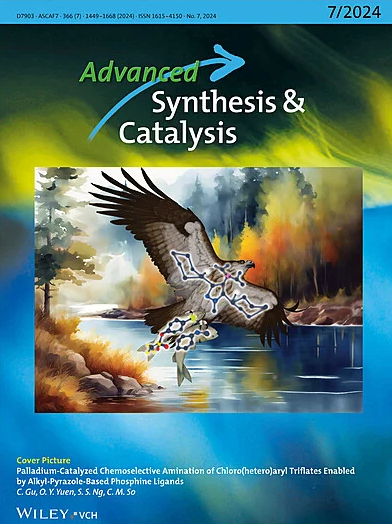原位合成炔基2,4′-联苯醌类化合物的有机催化远程控制对映选择性1,10加成
IF 4
2区 化学
Q2 CHEMISTRY, APPLIED
引用次数: 0
摘要
辅助基团的战略性结合最近建立了α功能化醇作为多功能亲电烷基化试剂,使远程控制共轭加成成为可能。引人注目的是,虽然醌类甲基化学已经得到了广泛的发展,但它们的扩展类似物——在联苯系统中具有空间分离的羰基和甲基单元——仍未被探索。在前人研究炔基4,4′-联苯醌的基础上,本文报道了一种由α -[4 -(2 -羟基苯基)苯基]丙炔醇与3 -芳基吲哚和吲哚- 2 -羧酸盐原位合成的炔基2,4′-联苯醌的有机催化远程选择性1,10 -加成,分别提供了广泛的对映富集的3H -吡咯[1,2 - a]吲哚和轴向手性四取代烯。结合对照实验,密度泛函理论计算阐明了反应机理,揭示了α -官能化醇脱水生成2,4 ' -联苯醌是反应的限速步骤,而对映选择性是由亲核加成的炔基联苯醌引起的。值得注意的是,除了证明2,4′‐联苯醌是有效的中间体之外,这项工作还通过证明它们参与了以前未报道的立体选择性1,10‐加成而开辟了新的领域。本文章由计算机程序翻译,如有差异,请以英文原文为准。
Organocatalytic Remote‐Controlled Enantioselective 1,10‐Additions of In Situ Generated Alkynyl 2,4′‐Biphenyl Quinone Methides
The strategic incorporation of auxiliary groups has recently established α ‐functionalized alcohols as versatile electrophilic alkylation reagents, enabling remotely controlled conjugate additions. Strikingly, while quinone methide chemistry has been extensively developed, their extended analogues—featuring spatially separated carbonyl and methide units across biphenyl systems—remain unexplored. Building on the prior work with alkynyl 4,4′‐biphenyl quinone methides, an organocatalytic remotely controlled enantioselective 1,10‐additions of in situ‐generated alkynyl 2,4′‐biphenyl quinone methides from α ‐[4‐(2‐ hydroxyphenyl)phenyl]propargyl alcohols with 3‐arylindoles and indole‐2‐carboxylates is reported, affording a broad scope of enantioenriched 3H ‐pyrrolo[1,2‐a ]indoles and axially chiral tetrasubstituted allenes, respectively. Combined with control experiments, density functional theory calculations elucidate the reaction mechanism, revealing that the dehydration of α ‐functionalized alcohols to generate 2,4′‐biphenyl quinone methides constitutes the rate‐limiting step, while enantioselectivity arises from the nucleophilic addition of alkynyl biphenyl quinone methides. Notably, beyond proving 2,4′‐biphenyl quinone methides as competent intermediates, this work breaks new ground by demonstrating their participation in previously unreported stereoselective 1,10‐additions.
求助全文
通过发布文献求助,成功后即可免费获取论文全文。
去求助
来源期刊

Advanced Synthesis & Catalysis
化学-应用化学
CiteScore
9.40
自引率
7.40%
发文量
447
审稿时长
1.8 months
期刊介绍:
Advanced Synthesis & Catalysis (ASC) is the leading primary journal in organic, organometallic, and applied chemistry.
The high impact of ASC can be attributed to the unique focus of the journal, which publishes exciting new results from academic and industrial labs on efficient, practical, and environmentally friendly organic synthesis. While homogeneous, heterogeneous, organic, and enzyme catalysis are key technologies to achieve green synthesis, significant contributions to the same goal by synthesis design, reaction techniques, flow chemistry, and continuous processing, multiphase catalysis, green solvents, catalyst immobilization, and recycling, separation science, and process development are also featured in ASC. The Aims and Scope can be found in the Notice to Authors or on the first page of the table of contents in every issue.
 求助内容:
求助内容: 应助结果提醒方式:
应助结果提醒方式:


